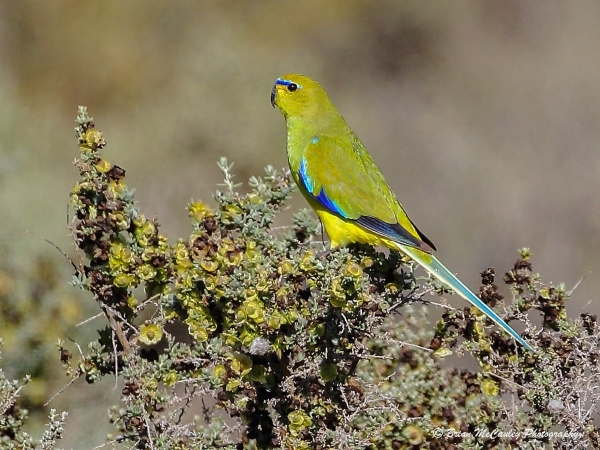The ultimate “most beautiful parrot in the world” can only be determined subjectively and based on personal taste. Nonetheless, a few parrots stand out due to their exquisite plumage and distinctive features. The elegant parrot is one of them and the most beautiful in the world. In this article, we will explore the facts about an elegant parrot.
Family: The elegant parrot (Neophema elegans) is a species of the old-world parrot family Psittaculidae. It belongs to the subgenus Neonanodes, and it is one of the six species of grass parrots in the genus Neophema.
Habitat: The elegant parrot is found in pen country, including coastal sand dunes, lightly timbered grasslands and cultivated paddocks, mallee, acacia scrublands, and arid saltbush plains. Also lives in the fringe zone between pasture and high forest. In South Western Australia, the Elegant Parrot is extending its range and increasing its numbers by colonizing the scattered clearings.
Behavior: The birds congregate in flocks of 20 to 100 or more, except in the breeding season, when they are usually seen in pairs or small parties. They are sometimes found in the company of blue-winged parrot, which they closely resemble in habits and appearance. More yellow-green and brilliant green plumage overall are found in the latter two species, respectively. When alarmed, elegant parrots often sit motionless and are not flushed until the last moment, when they fly to a nearby tree or land behind a bush or tussock.
Distribution: This bird is partly nomadic. Uncommon to rare only in the extreme east of the range. There are no races, notwithstanding two isolated populations in the southeast and southwest. Two distinct locations in Australia support the elegant parrot: one is southwestern Australia, extending from Moora in the north to Merredin and Esperance in the east, and the other is southeastern South Australia, which includes Kangaroo Island, and stretches north to Marree and east into western Victoria.
Elegant Parrot Diet: In lightly timbered open country, the bird’s plumage blends well with the grass in which the bird spends much of the day searching for seeds. The elegant parrot’s diet mainly consists of seeds of grasses and clover, but it also eats other vegetable matter, including berries and fruits. Native parrots can find foraging habitats in gardens with native grasses, groundcovers, and shrubs, including grevillea, banksia, hakea, and wattles.
Identification: Both adult sexes are similar in appearance. However, female birds are rather duller, with a variable yellowish underwing bar. Upper parts, including crown and nape, are rich golden olive; they are duller in females. The frontal band is deep blue, bordered above by a pale blue line extending over and beyond the eyes. The lores, throat, and forepart of the cheeks are bright yellow. Breasts are dull yellow-green. The rest of the underparts, including the underside of the tail, are bright yellow. Outer wing coverts and flight feathers are deep blue; shoulder patches are pale green-blue. The central tail feathers are dull blue and washed with olive; the outer tail feathers are blue and broadly tipped with yellow. The eyes are brown. The bill and cere are black. The feet and toes are mid-grey-brown. The immature birds are similar to adults, but the frontal band is vague or absent; a yellow underwing bar is present. Full adult plumage comes at only three or four months old. The downy young is white-downed and yellow-billed.
Alternative Names: Although elegant parrot is its popular name, it has also been known by several other names, like elegant parakeet, elegant grass parakeet, yellow lowry, and grass parrot, in the past.
Vocalization: Elegant parrot contact or position call is a sharp, reedy tsit-tsit-tsit, tsit-tsit-tsit in flight. Occasional plaintive, though penetrating, twittering was heard during feeding.
Flight: Their flight is high, swift, and direct, its delicate fluttering interspersed with brief glides on half-spread wings, except over short distances, when it can be low and erratic. When alighting, they spread the tail.
Courtship: In courtship, the male raises his wings and spreads his tail before bobbing and feeding the female, by regurgitation.
Size: An elegant parrot measures about 210–220 mm long, including a narrow-tapered tail. The weight is around 40–51 grams (1.4–1.8 oz)
Nesting and Breeding: Elegant parrot nesting and breeding occur in August–November or after rainfall. One, or sometimes two, broods are raised during the breeding season. They build nests in a hollow limb or hole in a tree that is more than 12–15 meters (40–49 feet) above the ground; they are typically eucalypts near a stream or in a forest of stringybark.
Eggs and Incubation: The bird lays 4-5 white eggs; rounded, 21–22 x 18 mm. Laid on decayed wood dust lining the bottom of the hole. The incubation period is about 17–18 days for females. Young fledge in about 4 to 5 weeks; maintain loose association with parents within the flock.
In culture: Aboriginal peoples called the elegant parrot “carteri,” bilgir, or koolyederong. (Across Australia, aboriginal people are represented by over 250 language groups, each with a unique culture and diversity. The proportion of Aboriginal people in Australia is about 3%).
Taxonomy: Famous ornithologist and artist John Gould gave it its English name in 1837.
Names in other popular languages:
-
Danish: Elegant Græsparakit
-
Norwegian: Elegantparakitt
-
Swedish: Gräsparakit
-
French: Perruche élégante
-
German: Schmucksittich
-
Polish: lakówka modrobrewa
-
Portuguese: Periquito-elegante
-
Dutch: Prachtparkiet
-
Italian: Pappagallo elegante
-
Spanish: Periquito Elegante

The ultimate, most beautiful parrot in the world can only be determined subjectively and based on personal taste. Elegant Parrot stand out due to their exquisite plumage and distinctive features. Photo Credit: Brian McCauley
Related Reading: Australian King Parrot
References and other information:
-
Listen to the call
-
Wikipedia
-
Avibase
-
BirdLife International
-
Parrots: A Guide to Parrots of the World, Juniper and Parr, 1998
-
BirdLife Australia
-
Video Links: Video 1 | Video 2 | Video 3
-
Parrots in Aviculture, Low, 1992.
-
Lexicon of Parrots, Thomas Arndt.






